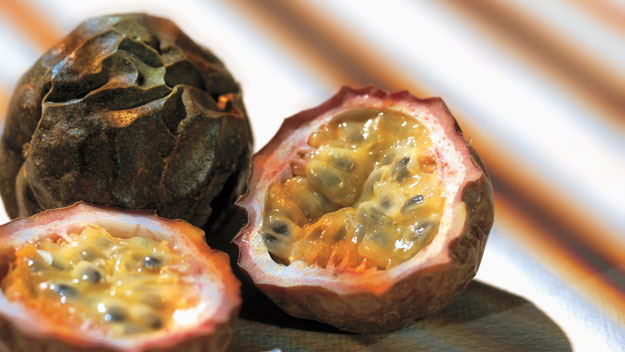For many years, the first thing I did when I came home was eat a passionfruit. When I was small, a passionfruit vine grew over our outdoor toilet, in the days before the last of the Brisbane suburbs were connected to the sewerage system. By the time I was in high school, our passionfruit vine grew over the fence instead. And while I was at uni, we had an enormous vine growing up an avocado tree.
These days I’m living in a colder climate, and a passionfruit vine grows against the stone wall above my study window. I can enjoy the white and purple flowers in spring and summer, the plop of purple fruit, and the red-browed finches which build their nest in the vine every spring.
But mostly, I still love eating the fruit! There is nothing like a sun-hot, freshly picked passionfruit. Eat the flesh straight from the vine with a spoon. Scoop it over ice-cream, or stir into orange and other juices, on pavlovas and on iced cakes or in cream sponges. Add pulp instead of liquid in plain cake or biscuit recipes to make them passionfruit-flavoured instead.
Passionfruit are one of the most generous fruits you can grow. They take up almost no room, as they need to clamber onto something. Cover up a bare or ugly fence with a passionfruit vine, or grow them over a trellis or pergola. They grow fast, too. In hot climates you’ll have fruit in a few months; in cooler ones you may have to wait a year.
Passionfruit would be worth growing even if they didn’t fruit, with their white and purple flowers, and glossy leaves. The banana passionfruit, which is even more tolerant of the cold and more vigorous than ordinary passionfruit, has enormous, vivid pink flowers instead.
Passionfruit have a reputation for being short-lived — and it’s true that they may have to be replanted every five years. But the vines grow so fast and so easily that this is no hardship. Try planting a passionfruit at one end of your fence now and in three years’ time, plant another at the other end. By the time your first passionfruit has lost its vigour the other will be thriving.
Where to grow:
Ordinary passionfruit do best in temperate to subtropical climates. In cooler areas try banana passionfruit in protected spots against a sunny wall or, in tropical areas, plant big, juicy granadilla. In all cases buy grafted vines — they are much hardier and faster growing than seedlings. All passionfruit vines need full sun and shelter from winds. Passionfruit also grow very well in large pots on a balcony.
Keeping them alive:
A poorly growing passionfruit vine usually gets sick; the leaves turn yellow or the fruit becomes thick-skinned with no pulp inside. This is usually due to a virus — but only poorly growing passionfruit get it. A strongly growing vine outgrows almost all problems, including root rots and pests. Feed plants each month with a scatter of hen manure; give at least one dose of seaweed fertiliser a year and mulch!
Most passionfruit are grafted and the graft suckers. Pull the suckers up at once or they can wander all over the place. They’re easy to spot; the leaves will be narrow and the vine will be narrower, too.
Harvest:
In warm areas the vines fruit most of the year; in colder areas in late summer. Pick the fruit when they change colour or shrivel just slightly, or when they drop off the vine.
Store:
Pick passionfruit for storage when they have a good rich colour and feel heavy. If you are buying them, choose heavy ones, too; light ones have less pulp. They will keep for several months in the fridge or a cool cupboard, but will gradually lose their sweetness. Passionfruit pulp can be frozen in iceblocks for later use.
Passionfruit cordial:
Does anyone out there remember what Passiona soft drink used to taste like when they were five years old. Well, homemade passionfruit cordial tastes like that but a hundred times better. It is one of those lovely luxuries that every home should have. Here’s how to make your own.
2 cups white sugar
1 cup passionfruit pulp
3 cups water
juice of two large lemons
2 level teaspoons tartaric acid
Place the white sugar and water in a saucepan. Boil for five minutes. Add the passionfruit pulp, tartaric acid and lemon juice. Boil for five minutes. Strain. Throw the pulp to the chooks. Bottle the liquid.
To use: Place a couple of tablespoons in a glass; add cold water.
To store: Keep in a cool place, either a dark cupboard or the fridge, for up to a month. Throw it out if it bubbles, looks or tastes peculiar or grows mould.


